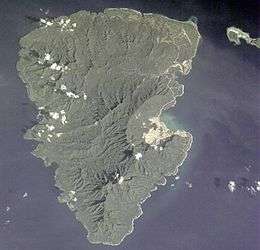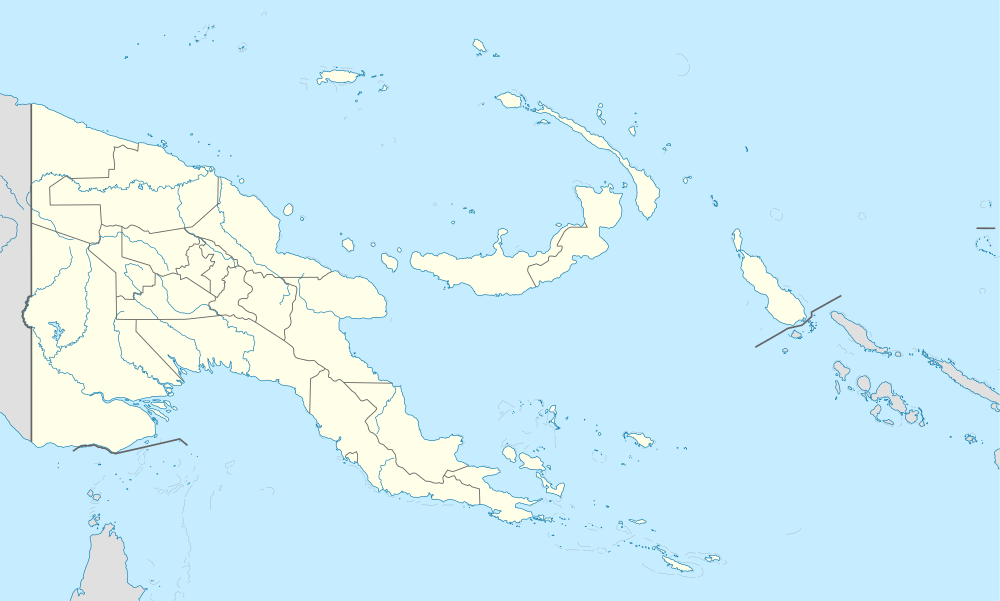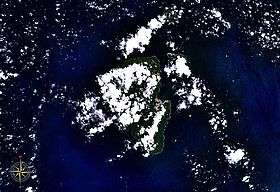Lihir Island
Lihir Island (a.k.a. Niolam Island) is the largest island in the Lihir group of islands, 22 km long and 14.5 km wide, in Papua New Guinea's New Ireland Province. It consists of a complex of several overlapping basaltic stratovolcanoes rising 700 m above sea level. While the volcanoes are not currently active, geothermal activity is still present. The island is in what was the forearc basin associated with the subduction of the Pacific Plate beneath the North Bismarck Plate.[1] Subduction stopped about 10 million years ago with the collision of the Ontong Java plateau with the subduction zone.[2]
| Native name: Niolam | |
|---|---|
 NASA Space Shuttle image of Lihir Island | |
 Lihir | |
| Geography | |
| Location | Melanesia |
| Coordinates | 3°7′30″S 152°38′30″E |
| Archipelago | Bismarck Archipelago |
| Total islands | 4 |
| Major islands | 1 |
| Length | 22 km (13.7 mi) |
| Width | 14.6 km (9.07 mi) |
| Highest elevation | 700 m (2,300 ft) |
| Administration | |
Papua New Guinea | |
| Province | New Ireland Province |
| Demographics | |
| Population | 18,000 |
The island is located 900 km (560 mi) NE of Port Moresby. Annual rainfall averages 4,800 mm (190 in); temperature ranges between 19 and 35 degrees Celsius. The population of the Lihir Group increased from 12,570 in 2000[3] to an estimated 18,000 in 2007. Residents are of Melanesian descent and have predominantly a subsistence lifestyle.
Lihirians follow traditional belief systems, although official census records indicate that 99% of the PNG population are Christians, with Catholicism being the largest denomination. Most villages are located on the coastal fringe, although it is thought that originally some villages were located inland but were moved to the coast at the encouragement of missionaries.
The economic focal point of the island is the Ladolam Gold Mine.[4] Ladolam represents one of the largest epithermal gold deposits in the world and it is hosted by high-potassic igneous rocks.[5] The mine is operated by Newcrest Mining Limited. The mine holds one of the world's largest gold resources (46 million ounces). Grab samples from the submarine Conical Seamount, located about 8 km south of Lihir Island, contain high gold concentrations of up to 230 g/t Au (avg. 26 g/t, n=40) that are hosted by high-potassic trachybasalts.[6]
The mine is located on a geothermically active area and to enable the mine to proceed, steam relief wells have been drilled to release subterranean pressure. The steam has, in part, been captured and is used to operate a 50 MW geothermal power station which generates approximately 25% of the mine's power requirements. Mine tailings are discharged into the sea.
The largest settlement on the Island is Londolovit, where most of the expatriate mine employees live. Basic shopping and health care facilities are located there. The local hospital has inpatient and outpatient facilities and provides health care services to both the expatriate and local communities.
An airstrip large enough to land a small jet is also located north of Londolovit, at Kunaye.
As is the case in many tropical regions, mosquito-borne viruses are present on the island, as is malaria.
Land ownership follows traditional models with land being owned by clans. Insofar as it relates to land ownership, the society is matrilineal with land being passed through the female generations. The land cannot be sold; however, usage rights can be granted.
The Island has two largest Primary Schools and a Secondary School Located on the Mining impacted area. The largest of the two Primary schools is Sekunkun Primary School which is on the North Eastern part of the Island. The school has total of over 600 students and 19 teachers.
References
- "Submarine Volcanoes". Department of Geosciences, Oregon State University. Retrieved 9 March 2011.
- McInnes, Brent I. A.; Jannene S. McBride; Noreen J. Evans; David D. Lambert; Anita S. Andrew (1999-10-15). "Osmium Isotope Constraints on Ore Metal Recycling in Subduction Zones". Science. AAAS. 286 (5439): 512–516. doi:10.1126/science.286.5439.512.
- (PNG Census 2000)
- Muller D., Groves D.I. (2016) Potassic igneous rocks and associated gold-copper mineralization (4th ed.). Mineral Resource Reviews. Springer-Verlag Heidelberg, 311 pp
- Muller, Daniel; Leander Franz; Peter Herzig; Steve Hunt (2001). "Potassic igneous rocks from the vicinity of epithermal gold mineralization at Lihir Island, Papua New Guinea". Lithos. 57: 163–186. doi:10.1016/s0024-4937(01)00035-4.
- Muller, Daniel; Leander Franz; Sven Petersen; Peter Herzig; Mark Hannington (2003). "Comparison between magmatic activity and gold mineralization at Conical Seamount and Lihir Island, Papua New Guinea". Mineralogy and Petrology. 79: 259–283.
